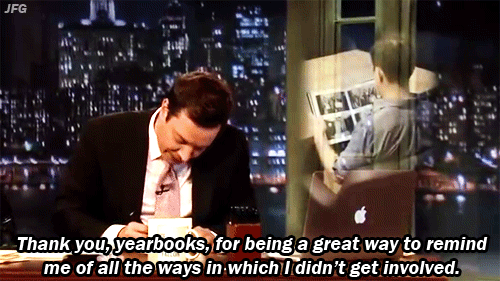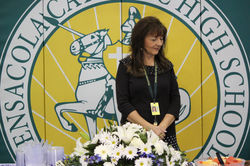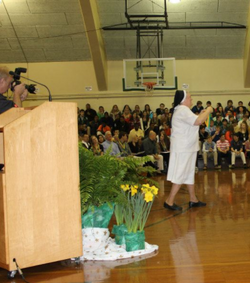ENC 2135
In the first hour of the first day of my senior year, I stood gazing at the schedule that had just been thrust into my hands. Picking my head up, I observed that everyone else in the hallway, schedules in hand, was already rushing to their first class of the day. Their upheld chins and sure-footed movements indicated they knew exactly where to go. Glazing my eyes back over my own schedule, I decided that there must be some error on my slip. The paper indicated that my first class would be held in room six-hundred, however, our school only had five hallways, each containing classrooms numbered within their respective century. In my four years at Pensacola Catholic High School, I had never heard of a room, hallway, or office with a numerical value anywhere near six-hundred. Racing against the five-minute time period that was allotted between classes, I spun my body and began propelling myself to the office with the intention to ask for assistance. Halfway down the poster clad corridor, my attention was drawn to a dark and otherworldly door. The door itself was steel and had no windows, which was a great contrast to the other wooden doors in the hallways, where large Plexiglas windows allowed viewers from the hallway to peer inside. Beside the door was a sign that read, “Basement: Maintenance, Storage, 600-603.” With about thirty seconds to spare, I swung open the mystery door & descended into the dusty understructure of the school.


My senior year Yearbook class was held in a closet.
The sooty concrete floor exhibited scuff marks dating back to the founding years of the school.
My senior year Yearbook class was held in a closet. The sooty concrete floor exhibited scuff marks dating back to the founding years of the school. Each corner contained bookshelves crammed with old yearbooks, binders, and scraps of loose papers peeking out every which way. The room was barely big enough to comfortably fit the eleven total staff members and our computers. However, the forced physical closeness of myself to my colleagues allowed me to build relationships with people I would likely have otherwise never spoken to, and who would have never spoken to me. They physical closeness laid the foundation for a spiritual closeness, which was exemplified in the final draft of the 2016-2017 yearbook. This closeness, however, took time to come to fruition.
Each member was assigned distinct spreads to curate. The individual assigned to the page was responsible for coordinating the photographs, writing the copy, and editing the layout. Essentially, members were expected to turn a completely blank slate into a beautiful and well-designed page. The one exception to this method of individual craftsmanship was page 126. This page was to contain the work of each and every member of the yearbook staff. Being the first spread that was tackled in the whole book, it served as the groundwork for the members to build upon. It is my favorite page because it reflects the disordinance that occurred among myself and my colleagues at the beginning of the year.

The spread was for the first school-wide event of the year – an induction ceremony for the new members of the National Honor Society. Myself and three other members of the yearbook staff were tasked to photograph the event. Another three members were tasked with “notetaking,” which consisted of recording any inspiring quotes, significant occurrences, or anything that would be useful for fashioning the context of the page. The final three members were appointed to interview people of interest at the conclusion of the event. In this case, this included the president of the club, the guest speaker, and the principal.
 Pictures Taken at the Ceremony |  Pictures Taken at the Ceremony |  Pictures Taken at the Ceremony |
|---|---|---|
 Pictures Taken at the Ceremony |  Pictures Taken at the Ceremony |
In the class period following the event, we all came together and presented the material we had accumulated. While it may seem that because we were all operating on the same event, we, as a group, should have a consistent vision of the page we were to make, this was absolutely not the case. Everyone had seen the event from a different perspective. I myself had focused on the actual essence and aesthetic of the ceremony, having taken pictures of the banners, the cake, and the beautiful flowers that lined the procession aisle. Another photographer had taken hundreds of photos of individuals with their certificate and pin in hand. Yet another photographer had taken a multitude of group shots, meaning picture after picture of a mass of heads – far too cluttered and disordered for even the sharpest of eyes to focus on. Some note takers had hooked onto the message of individuality, while some were more inspired by the idea of a group as a whole working toward a common goal. Everyone had varying ideas on how the page should be structured.
I would like to say that we came together and managed to mold everybody’s ideas into a cohesive and beautiful sheet, however, the honest truth is that the page was a mess. The background was an excessively zoomed in photograph I had taken of flowers that lined the reception hall. Fifty small boxes of varying size that lined the perimeter of the spread contained individual photos of each of the inducted members. Various spots were stamped with group photos of hundreds of heads that would cause anyone with typophobia serious consternation. The text on the page bore different messages – some about the power of the individual, and some about the importance of occasional conformity and working as a group. Overall, the spread looked as though it was the story of seven or eight contrasting events. As much as we wanted to fine-tune it, our submission date was fast approaching, and therefore the page was yielded to the program to be print in the final edition.


As genuinely awful as this page was, I continue to look back on it with fondness. It is an accurate reflection of the spaces between myself and my fellow yearbook members. As the year went on, our close proximity forced conversations among us so that the eerie silence of the basement did not drive us to insanity. We all became very close friends, and began consulting one other for ideas and opinions about our pages. When photographing or notetaking or interviewing during events, we consulted one another in order to gather material for a united product. I learned to compromise and to accept another’s ideas in place of my own. The result of this gradually crafted bond was a deep and soulful understanding of the pieces that made up my fellow members. This sympathetic love for one another showcased in the product of the class – the 2016-2017 yearbook. It was beautiful. Instead of each spread being inherently different, any reader with an observant eye could see the connection from page to page of the book. It was not hard to contrast the rest of the book to the first page we had worked on together. The change echoed our growth as a yearbook community. The book that we had spent all year toiling over in a cramped room in the basement of our school was cohesive and magnificent – all expect for page 126.


